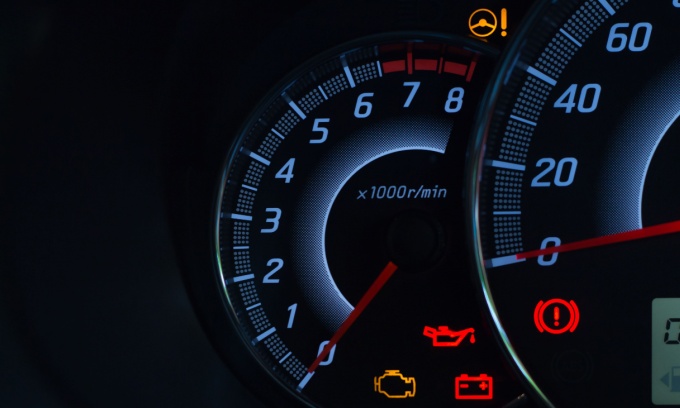What does the colour of the car warning symbol mean?
It’s a good idea to note the colour of any symbol that lights up on your car’s dashboard. This can often indicate how serious the problem is.
According to car dealer Motorama, a red warning light suggests there may be a serious problem, an orange or yellow warning light may mean that something needs to be checked or serviced soon, and a green or blue light typically indicates that a system is operating normally—for example, if you turn on your headlights or use your hand/parking brake.
Keep in mind that your car’s warning lights may vary in appearance and colour depending on your vehicle’s manufacturer and model. For more information on your own car’s warning symbols, refer to your owner’s manual.
Common dashboard car warning symbols and what they mean
1. Engine temperature light
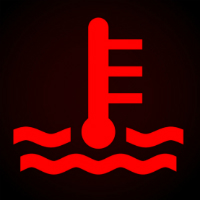
If this thermometer-shaped symbol lights up, car insurance provider NRMA says it means your engine is not at its recommended temperature. In most modern cars, the symbol will be blue if the engine temperature is too cold, and red if it’s too hot. If the light is blue when you first start up your car, it will typically turn off after a minute or so once your engine warms up to the right temperature. If the light is red, then there may be a problem with your coolant. If your car is overheating, NRMA recommends pulling over to a safe location and calling roadside assistance for help.
2. Oil pressure light
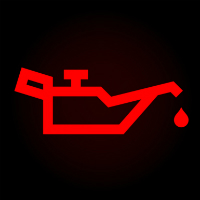
Shaped like an old-fashioned oil can, this symbol will light up if your oil pressure is too low. This may be because there isn’t enough oil in your car’s system or the oil pump may be faulty. It’s recommended that if this symbol is lit up, that you stop driving as soon as possible, let your engine cool down and check your oil level.
3. Check engine light
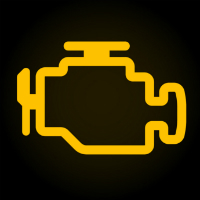
The check engine light is fairly self-explanatory as it appears in the shape of a car engine, and indicates that there’s something wrong with yours. This could be something minor, like a loose petrol cap, or it could signal a more serious issue with your engine. If this light turns on, get your engine checked out by roadside assistance or a mechanic as soon as possible.
4. ABS light
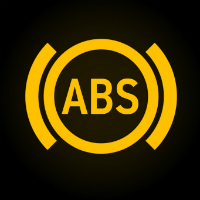
If the ABS light illuminates, this indicates there’s an issue with your Anti-lock Braking System (ABS) and it may be disabled. Your ABS is designed to stop your wheels from locking up and skidding when braking under adverse conditions, like on slippery roads. Your car can still be driven with just the standard brakes, but you should take extra care if you do so and should go to a mechanic as soon as you can.
5. Battery light
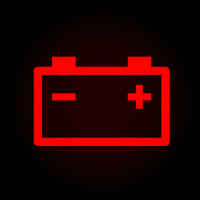
This battery shaped light indicates there’s a problem with your battery’s charging system. It could mean there is an issue with the car battery itself or an issue with the alternator (which is what generates the power that’s stored in the battery). If your battery light illuminates when you turn on the ignition and your car won’t start, this means your battery is probably flat. You may be able to get the vehicle started with a jumper cable—if you have one available, as well as access to another working vehicle. You may need to call roadside assistance for a new battery or see a mechanic and have the battery and charging system checked out.
6. Brake light
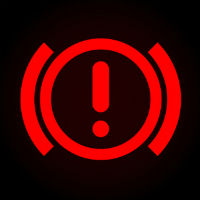
As you may already have noticed, your brake light will turn on when your hand or parking brake is engaged. However, if it lights up when the brake is fully released, your car may be low on brake fluid or there could be a malfunction in the braking system itself. It’s recommended to pull over immediately and call roadside assistance.
7. Airbag light

If a light that looks like a person strapped into their seat with a circle floating above them illuminates, then it’s your airbag light. This indicates that there’s something wrong with one or more of your airbags, or with the system as a whole. It’s recommended that you go to a mechanic as soon as possible. Otherwise, you could run the risk of your airbags not deploying correctly in the event of a crash.
It’s also important to check whether your car is affected by a compulsory recall for defective items (e.g. Takata airbags). You can check whether your vehicle is affected by contacting your vehicle’s manufacturer, or by visiting Vehicle Recalls Australia or IsMyAirbagSafe.com.au.
8. Traction control light
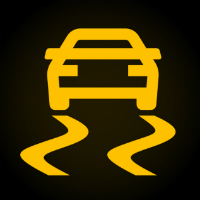
Your traction control light is usually shaped like a swerving car. Most modern cars will have an integrated traction control system. This system is designed to help you maintain control and stability of your car and stop your car from skidding if it’s losing traction.
In most cases the light will come on when you’re accelerating. If it illuminates, this may mean there’s a problem somewhere in your vehicle or with the computing system itself. It’s recommended to drive slowly and find somewhere safe to stop, before calling a mechanic or roadside assistance.
Some traction control lights will come on when there’s rainy or snowy weather and then the light will go away. If this happens, it may mean that the system has been activated. Read your owner’s manual to see how your car’s traction control system works and what to expect.
9. Security light
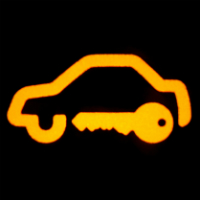
Your car’s security light usually looks like a car with a key or a padlock. It might light up briefly when you turn your car on, which generally doesn’t mean anything is wrong. However, if it turns on when your car’s engine is running, it may mean your car’s anti-theft system is malfunctioning. If this is the case, it’s a good idea to head to a mechanic and get it checked out.
10. Automatic transmission light
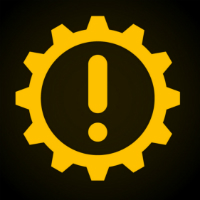
This light indicates there’s something wrong with your car’s automatic transmission. It looks like a cog with an exclamation point in the centre. Your automatic transmission monitors things like fluid temperature, fluid level and the pressure inside the transmission. If this symbol appears, it’s recommended that you get this checked as soon as possible, as transmission problems can be expensive to fix.
11. Low tyre pressure light
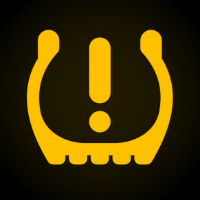
The low tyre pressure light indicates that the pressure in one or more of your car’s tyres is too low. It looks like a tire with an exclamation point inside it. Pull over when it’s safe to do so and visually check your tyres for any punctures (you may need to replace your tyre if you do see a puncture). However, if the tires appear to be intact, head to a service station, check their air pressure and inflate them to the recommended level.
12. Fog light
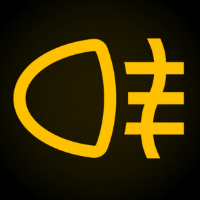
The fog light symbol will light up when you turn on your fog lights. This looks similar to your headlight symbol, except instead of multiple lines pointing down, it has a wavy line with three lines through it. Fog lights are typically low-mounted lights that are designed to make it easier to see the road in foggy conditions, but they can dazzle other road users if there is no fog. Make sure you only use them when it’s appropriate to do so. All Australian states and territories have laws making it illegal to use fog lights when there’s no fog or mist affecting your visibility.
13. Steering lock light
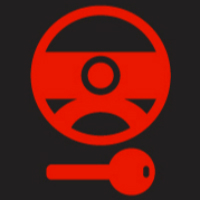
Your steering lock light will usually look like a steering wheel with a key or a padlock next to it. The steering lock is an anti-theft feature that automatically locks the steering wheel if it’s moved when your car is off. If the steering lock is activated, you can turn it off by turning your keys in the ignition while turning your wheel in either direction. This shouldn’t take much force.
14. Low fuel level light
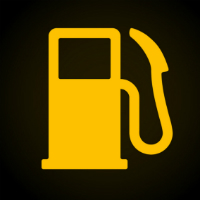
There’s a good chance you’ve seen this symbol before. Resembling a fuel pump, it simply means your car is running low on fuel. Depending on the make and model of your car, you may be able to drive about an extra 40 to 183 kilometres after the low fuel light comes on. Instead of risking it though, it’s a good idea to pull into a petrol station to fill up sooner rather than later.
15. Low washer fluid light
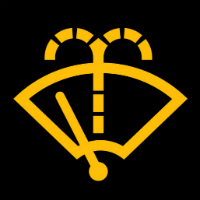
This symbol looks like a windscreen with water spouting out. It will light up if your car is running low on washer fluid. Washer fluid helps to keep your front and rear windshields clean and helps remove dirt and debris. If you see this symbol, it’s a good idea to refill the washer fluid tank as soon as you can. While you can use plain water, specialised washer fluid contains chemicals that make it easier to clean up debris. It may also contain ethanol or antifreeze to stop it from freezing on your windscreen during cold weather. Your windscreen washer fluid tank is located under the hood of your car, and it usually looks like a white, translucent container with a windshield/water symbol on the cap. If your car has a rear windscreen wiper, there may also be a second tank for this.
How to get roadside assistance if you need it
If your car battery dies, you get a flat tyre or you run out of fuel, roadside assistance can generally help fix your problem. Roadside assistance is available from motoring clubs like AANT, NRMA, RAA, RAC, RACQ, RACT and RACV, and it can also be included in your car insurance as a standard feature or an optional extra at an additional cost. Major car companies may also offer roadside assistance as part of their new car warranty.
If you’re looking for a new car insurance policy, you can compare car insurance with Canstar. It’s important to read any relevant documentation, such as the Product Disclosure Statement (PDS) and Target Market Determination (TMD), for any policy you’re considering.



